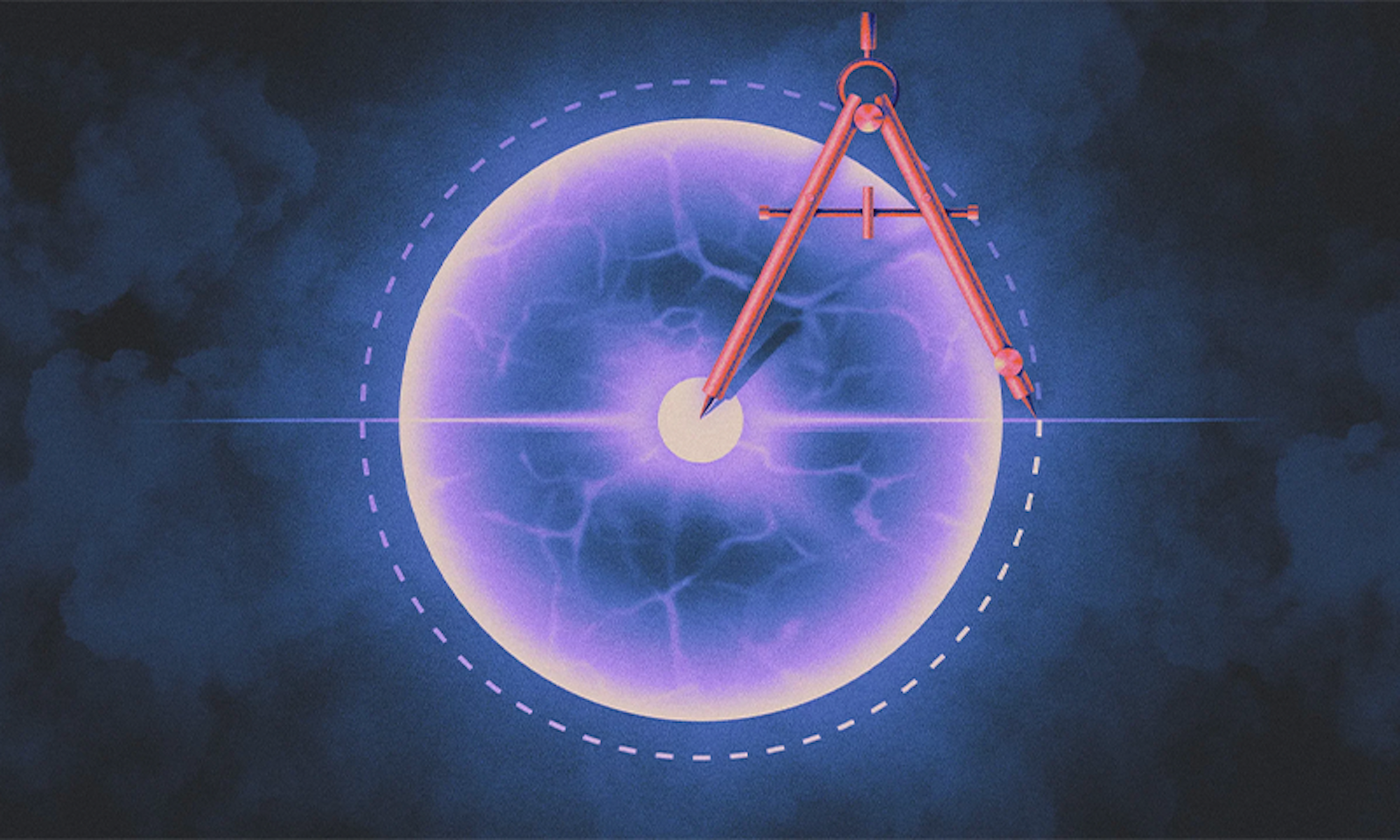Imagine an electron as a spherical cloud of negative charge. If that ball were ever so slightly less round, it could help explain fundamental gaps in our understanding of physics, including why the universe contains something rather than nothing.
Given the stakes, a small community of physicists has been doggedly hunting for any asymmetry in the shape of the electron for the past few decades. The experiments are now so sensitive that if an electron were the size of Earth, they could detect a bump on the North Pole the height of a single sugar molecule.
The latest results are in: The electron is rounder than that.
The updated measurement disappoints anyone hoping for signs of new physics. But it still helps theorists to constrain their models for what unknown particles and forces may be missing from the current picture.
“I’m sure it’s hard to be the experimentalist measuring zero all the time, [but] even a null result in this experiment is really valuable and really teaches us something,” said Peter Graham, a theoretical physicist at Stanford University. The new study is “a technological tour de force and also very important for new physics.”
Poaching Elephants
The Standard Model of Particle Physics is our best roster of all the particles that exist in the universe’s zoo. The theory has held up exceptionally well in experimental tests over the past few decades, but it leaves some serious “elephants in the room,” said Dmitry Budker, a physicist at the University of California, Berkeley.
For one thing, our mere existence is proof that the Standard Model is incomplete, since according to the theory, the Big Bang should have produced equal parts matter and antimatter that would have annihilated each other.
In 1967, the Soviet physicist Andrei Sakharov proposed a possible solution to this particular conundrum. He conjectured that there must be some microscopic process in nature that looks different in reverse; that way, matter could grow to dominate over antimatter. A few years before, physicists had discovered such a scenario in the decay of the kaon particle. But that alone wasn’t enough to explain the asymmetry.
Ever since then, physicists have been on a hunt to find hints of new particles that could further tip the scale. Some do so directly, using the Large Hadron Collider—often touted as the most complicated machine ever built. But over the past several decades, a comparatively low-budget alternative has emerged: looking at how hypothetical particles would alter properties of known particles. “You see footprints [of new physics], but you don’t actually see the thing that made them,” said Michael Ramsey-Musolf, a theoretical physicist at the University of Massachusetts, Amherst.
Our mere existence is proof that the Standard Model is incomplete.
One such potential footprint could appear in the roundness of the electron. Quantum mechanics dictates that inside the electron’s cloud of negative charge, other particles are constantly flickering in and out of existence. The presence of certain “virtual” particles beyond the Standard Model—the kind that could help explain the primordial supremacy of matter—would make the electron’s cloud look slightly more egg-shaped. One tip would have a bit more positive charge, the other a bit more negative, like the ends of a bar magnet. This charge separation is referred to as the electric dipole moment (EDM).
The Standard Model predicts a vanishingly tiny EDM for the electron—nearly a million times smaller than what current techniques can probe. So if researchers were to detect an oblong shape using today’s experiments, that would reveal definitive traces of new physics and point toward what the Standard Model might be missing.
To search for the electron’s EDM, scientists look for a change in the particle’s spin, an intrinsic property that defines its orientation. The electron’s spin can be readily rotated by magnetic fields, with its magnetic moment serving as a sort of handle. The goal of these tabletop experiments is to try to rotate the spin using electric fields instead, with the EDM as an electric handle.
“If the electron’s perfectly spherical, it’s got no handles to grab onto to exert a torque,” said Amar Vutha, a physicist at the University of Toronto. But if there’s a sizable EDM, the electric field will use it to tug on the electron’s spin.
The dream is that these EDM experiments will be the first to detect signs of new physics.
In 2011, researchers at Imperial College London showed that they could amplify this handle effect by anchoring the electron to a heavy molecule. Since then, two main teams have been leapfrogging one another every few years with increasingly precise measurements.
One experiment, now at Northwestern University, goes by the name of Advanced Cold Molecule Electron EDM, or ACME (a backronym inspired by the old Road Runner cartoons). Another is based at the University of Colorado’s JILA institute. The competing teams’ measurements have jumped in sensitivity by a factor of 200 in the last decade—still with no EDM to be seen.
“It is sort of a race, except we have no idea where the finish line is, or whether there is a finish line, even,” said David DeMille, a physicist at the University of Chicago and one of the leaders of the ACME group.
A Race to the Unknown
To keep trekking ahead, researchers want two things: more measurements and a longer measurement time. The two teams take opposite approaches.
The ACME group, which set the previous record in 2018, prioritizes quantity of measurements. They shoot a beam of neutral molecules across the lab, probing tens of millions of them every second, but only for a few milliseconds each. The JILA group measures fewer molecules, but for longer: They trap a few hundred molecules at a time, then measure them for up to three seconds.
The ion-trapping technique, first developed by Eric Cornell, a physicist at the University of Colorado, Boulder who directs the JILA group, was “a big conceptual breakthrough,” DeMille said. “Many people in the field thought this was nuts. Seeing it come to fruition is really exciting.”
Having two distinct experimental setups that can cross-check one another is “absolutely crucial,” Budker said. “I don’t have words to express my admiration of this cleverness and persistence. It’s just the best science there is.”
Cornell’s technique was first showcased in 2017 with hafnium fluoride molecules. Since then, technical improvements have allowed the group to surpass ACME’s record by a factor of 2.4, as described in a recent preprint led by Cornell’s former graduate student Tanya Roussy. The team declined to comment while their paper is under review at Science.
Probing the electron’s roundness with increased precision equates to looking for new physics at higher energy scales, or looking for signs of heavier particles. This new bound is sensitive to energies above roughly 1013 electron-volts—more than an order of magnitude beyond what the LHC can currently test. A few decades ago, most theorists expected that hints of new particles would be discovered significantly below this scale. Each time the bar rises, some ideas are discredited.
“We have to keep wrestling with what these limits imply,” Ramsey-Musolf said. “Nothing’s killed yet, but it’s turning up the heat.”
Meanwhile, the electron EDM community forges ahead. In future experimental iterations, the dueling groups aim to meet somewhere in the middle: The JILA team plans to make a beam full of ions to increase their count, and the ACME team wants to extend the length of their beam to increase their measurement time. Vutha is even working on “some totally crazy” approaches, like freezing molecules in blocks of ice, in the hope of jumping several orders of magnitude in sensitivity.
The dream is that these EDM experiments will be the first to detect signs of new physics, prompting a wave of follow-up investigations from other precision measurement experiments and larger particle colliders.
The shape of the electron is “something that teaches us about totally new and different pieces of the fundamental laws of nature,” Graham said. “There’s a huge discovery waiting to happen. I’m optimistic that we’ll get there.”
This article was originally published on the Quanta Abstractions blog.
Lead image: If an electron were the size of Earth, the experiment could detect a bump the size of a sugar molecule. Credit: Kristina Armitage/Quanta Magazine.




























